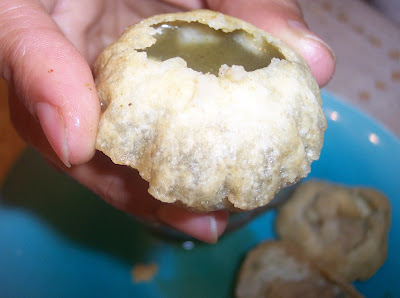
Evening 6 O'Clock and later....
A drizzly kind of day......
Boring, what to do?
Tired from work, need a break...
On a walk with friends/cousins/family....
Hungry, craving for a snack...
Confused??? Well, all the above are scenarios that can eventually lead you up to the paani-poori gaaDi/shop. Going to the nearby chaat center and eating paani-poori, masala poori, bhel puri, sev poori, dahi poori, etc., in the evenings has become second to tradition in India. My parents, in-laws abhor the very idea. But I have remained immune to all their lectures of 'junk food'. Cant help it, peer pressure ;-) ha ha haaa....
Everyone has their own fav chaat center. Back in India I have 2 favorites. One being the Chaat vendor in front of the Kote Aanjaneya Swami temple, in my hometown Shimoga. He amazingly whips up chaats from 'u name the item' Moong dal chaat, methi chaat, boti(the long cylindrical fryums, not non-veg) masala, nippat masala, chakli masala , coke masala(drink), are a few of his specialities. The other hot chaat spot is Gullu's chaat, Sheshadripuram, Bangalore. Situated in a coy residential area, it has transpotred the whole place into a bustling 'mela'. Come 6 in the evening and you wont find a parking spot there. He has employed a person just to take care of the traffic, imagine that! Even with the hundreds of customers that pour in, the guy serving paani pooris, immediately hands me a paper napkin cos he knows that I like to have 'running nose, watery eyes' kinda spicy paani with my pooris, with the last one being sweet. I call that customer service!
Now, I would never discredit all the others who range in between the above two. Each one serves the purpose of curbing your craving. What can beat that? Every time we shifted to a new place, we went hunting and discovered a chaatwalla, who would meet our specs and satisfy our taste palettes. Chaat eating in South India, is to an extent, confined to evenings. But I was surprised when I had been to Orissa once and saw people eating paani-pooris(or gupchup as it is cutely known as) at 11 in the morning! I know of chaat fanatics who cant do without it and US is a big place of disappointment in that area. I tried eating chaat at one such place here and it was such a revolting experience, I decided to make my own. To all those who say it is unhealthy, you should listen to what Nikhil Chinnappa has to say about it. I once read in some magazine, where he was asked about a fitness routine/diet. He said something to the effect of "Eat lots of golgappas(another cute name), fill yourself up with water". Cool, huh? Here's to all chaat lovers, my first in the Tamarind series! Enjoy!!!

Ingredients :
1 pack Pooris (You can make these at home too.. I tried but found that they are too crisp and dont hold up to the liquid)
For the Paani :
You can vary the quantity of salt, jaggery, tamarind, chillies etc., to reach a taste that suits you. The measurements given below are just a guideline.
1 bunch fresh Mint(Pudina) leaves removed from stems
2 cupfuls fresh Cilantro leaves removed from stems
5-6 Green Chillies(more or less according to your taste)
1 teaspoon Cumin seeds
1 tablespoon Tamarind Extract
1 tablespoon Date paste(optional)(You can use the ready tamarind-date paste that you get in the Indian grocery stroes)
2 teaspoons Jaggery, powdered
1 teaspoon Black Salt(Kaala Namak)
2-3 Cardamoms
Salt to taste
Jaljeera powder, chaat masala powder(These are optional. Use in moderation)
For the Filling :
You can use different kinds of filling, like, Peas-Potato, Boiled moong dal, Boiled Kabuli chana etc., Here, I have used a Yellow Peas and Potato filling.
3 Potatoes - boiled, peeled and mashed
1 cup Yellow Peas - Soaked overnight, and pressure cooked
1 teaspoon chilli powder
1/2 teaspoon garam masala powder
A pinch of turmeric powder
A pinch of dhania powder
A pinch of jeera powder
Salt to taste
For the Topoing :
1 onion, finely chopped
1 cupful finely chopped cilantro leaves
Method :
1. Grind all the ingredients for the paani to a smooth paste with sufficient water.
2. Add enough water(about 2 litres) and mix well.
3. Adjust the seasonings to taste.
3. Strain the mixture to get a clear green liquid.
4. Refrigerate.
5. In a bowl mix well, all the ingredients for the filling.
6. Adjust the seasonings to taste.
To Serve :
1. Make a small hole on the top of each of the pooris.
2. Stuff about 1/2 a teaspoon of the filling into each.
3. Top with chopped onions and coriander.(I mix these with the filling to make it easier)
4. Arrange 6 on a plate and serve paani in cup.
5. Be ready for 2nd, 3rd etc., helpings ;-)
















